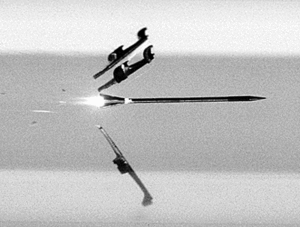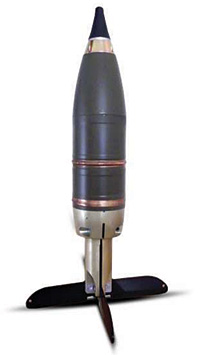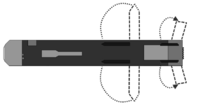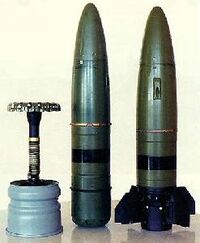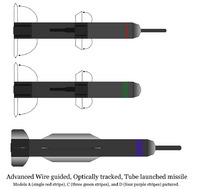Chaos Series
The Chaos Series is a series of munitions developed by Wolf Armaments for tank cannons. It is named after the mythical dragon Chaos, which has many heads that symbolizes the many types of munitions in the series. Although different in design, each munition is categorized under the Chaos Series due to the development program they were created under; both Wolf Armaments and the TECT Armed Forces adopted the designation system for all tank fired munitions. Munitions not fired from tank cannons are not included in the Chaos Series Project; munitions that were adopted or have a variant shot from tank cannons are given a name along with their original design name. Artillery shells are also not included in the Chaos Series even though some Commoner developed artillery possesses capabilities to fire their own anti-tank munitions.
Chaos munitions vary from type to purpose but all are fired from tank cannons. To date, Wolf Armaments produces tank munitions for rifled and smoothbore canons in calibers eighty millimeters to one hundred and twenty-five millimeters. One-hundred and forty millimeters is exempted as both Wolf Armaments and TECT classify this caliber as a tank destroyer caliber. Each division of the Project is given an identification number and variants are given letters and/or numbers to follow; an example would be the Chaos-1, which is the designation for HEAT munitions the Chaos Series - Chaos-1I2 is an example of one of the modern munitions used in this division. An example of the earlier mentioned adopted munitions is the Chaos-4A 'Speer', which is otherwise known as the Speer-GLATGM - guided munitions like the Speer's tank launched variant are listed under the Chaos-4 designation.
Munitions
Chaos-1

Under the designation 'Chaos-1' are HEAT munitions. A HEAT or 'High-Explosive Anti-Tank' munition is a type of munition that uses an explosive shaped charge that employs the Munroe Effect to create a high velocity partial stream of metal in a state of superplasticity, which is used to penetrate solid vehicle armor; explosive force and shrapnel are also capable of killing armored vehicles, or, other soft skinned targets. Such weapons were developed around the world during the 1930s and 40s in conjuncture with the invention of the shaped charge. HEAT warheads have since either been improved upon or have lost much of their effectiveness. Most HEAT warheads have lost their effectiveness against main battle tanks, which now feature spaced armor and spall liners. Newer HEAT warheads like tandem warheads and explosively formed penetrators have remained as serious threats for main battle tanks; a newer class of HEAT rounds have also featured multipurpose capabilities, defeating vehicle armor, helicopters, structures, and infantry. Lighter armored vehicles like armored personnel carriers are still susceptible to most HEAT munitions seeing as they are lighter, less armored, and usually have less unique armoring designs; these and older designed armored vehicles are the primary target for most HEAT munitions.
In TECT, HEAT rounds developed around the same time as it did in other nations and were used against both armored and infantry units. Of course these munitions eventually saw innovative improvements and uses in other weapons outside of tank cannons. Today there are three modern HEAT munitions in active service with the TECT Armed Forces and that are still in mass production; these are the 'Chaos-1I2 & I3' and 'Chaos-1J1'. The 'I' series is based around the age-old purpose of defeating armored foes - it focuses on defeating spaced/caged armor, ERA, and multi-layered armor on modern tanks by using innovative materials and features. I2 uses a copper liner for penetration against armor while I3 uses depleted uranium for improved armor penetration capabilities. Both munitions are sabot rounds that use a tandem warhead with three IMX-101 based explosive charges, including an improved detonator tip and wave shaper, steel spike, and low drag deploying fins. Both models are used and still being produced with the third model entering mass production in 2014. The 'J' series is the latest model of the Chaos-1, which features multipurpose capabilities as its primary design. J1's utilize a copper liner with a steel spike - said spike contains a detonator, nose cap switch, and a shoulder switch for full frontal area functioning. The nose cap allows loaders to utilize a proximity switch, letting tanks defend themselves against helicopter threats; J1's are equally effective against lighter skinned armored vehicles, infantry, and soft skinned structures like buildings or bunkers. J1's are sabot rounds that deploy low drag fins like I-Series rounds. All of the above munitions are produced in eighty, one-hundred and five, one-hundred and twenty, and one-hundred and thirty millimeter calibers, rifled and smoothbore, and a designated practice/and inert round produced as well (one-hundred and forty millimeters is listed under Sünde-1).
| Name | Portrait | Type | Penetration |
|---|---|---|---|
| Chaos-1I2 |  |
Anti-Tank/Armor, Multipurpose | Up to 550mm+ of RHA |
| Chaos-1I3 | 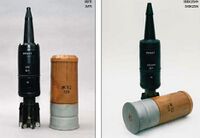 |
Anti-Tank/Armor, Multipurpose | Up to 800mm of RHA |
| Chaos-1J1 | 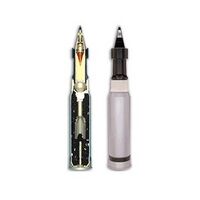 |
Multipurpose | Up to 500mm of RHA |
Chaos-2
Under the designation 'Chaos-2' are kinetic energy penetrators. Kinetic energy penetrators are ammunition designed to penetrate vehicle armor through the use of kinetic energy; KEPs do not use explosives but rather a sub-caliber dart-like penetrator carried by a sabot to penetrate vehicle armor, causing heat and spall damage as the penetrator forces its way through the vehicle's armor. This, along with kinetic force related damage, is intended to kill crew members inside or create catastrophic damage through secondary means (igniting ammunition and/or fuel, or destroying vehicle components/equipment). Once fired, a KEP munition leaves the barrel with the sabot splitting off from the penetrator almost immediately, allowing the slender dart-like penetrator to travel at high velocity to its intended target. Armor-piercing fin-stabilized discarding-sabot (APFSDS) is the most modern form of kinetic energy penetrators; APFSDS succeeds armor-piercing discarding sabot (APDS), which are still commonly used by smaller caliber weapon systems. Kinetic penetrators are intended to defeat enemy armor by penetrating and 'scaring' the armored vehicle; the heat and spalling generated by the penetrator going through the armor, and the pressure wave that would develop, ideally destroys the target. KEP ammunition has long been used before tanks - its history begins with arrows and rocks while cannons used similar methods for its own ammunition (wood was often used to separate the projectile and gunpowder, for instance). Their first use as anti-tank ammunition began during the 1930's and 40's as countries developed new ammunition along with new tank technology; KEPs were one of few ammunition types made specially to penetrate tank armor, though these early designs differed from modern designs.
In TECT, early KEPs were known as armor-piercing composite rigid rounds (APCR); APCR, like those around the world, were multi-layered and utilized different materials - they were heavy cored bullets that utilized a lighter outer layer. APCR was popular until APDS succeeded it; the Chaos Series was soon introduced with the first Chaos-2 ammunition, an APDS, designated the Chaos-2B. Today there are three KEP designs used and produced, these are the: 'Chaos-2K1 & K2' and the 'Chaos-2L1'. The 'K' series were the first APFSDS ammunition developed by Wolf Armaments when upgrading from older APDS ammunition; the K1 was the first design while the K2 was an improved upon model based on the earlier K1. L1, however, is the most recent design of the Chaos-2 series, which totally differs from the K series. The K series focuses on a finned, thicker designed, penetrator; penetrator length and thickness are proportioned out for a stable, powerful, and accurate design. K1 is made up of a sabot that holds the sub-caliber penetrator centered in the barrel; this sabot has two large spheres on bottom and top portions, holding the projectile centered in the cannon barrel. Constructed of tungsten carbide, the sub-caliber penetrator is incredibly dense and features four large rear positioned fins for low drag stabilization. The K2 is an upgraded version of the K1, which features improved smaller low drag fins, an improved composite single sphere sabot design, and sub-caliber penetrator made of an improved extremely high elongation tungsten alloy construction. K2 is characterized for its performance improvements, which are credited to its sleeker design and better penetration results achieved through an improved penetrator design. 'L' series ammunition is the latest design in Chaos-2. Unlike K1 or K2, the L1 design incorporates a sleeker, more powerful, penetrator that is vastly longer and smaller in diameter then earlier designs. The L1's penetrator is much smaller in diameter, larger lengthwise, and uses a much smaller series of fins for stabilization. These features are key to the design so that the penetrator's velocity is improved and degrades less over time; the velocity is increased due to a different propellant charge amount/system and the previously mentioned penetrator. L1's damage performance is improved further with the penetrator's depleted uranium construction, which induces a pyrophoric effect and produces a significant adiabatic shear band. Chaos-K1/2 and L1 ammunition is produced in eighty, one-hundred and five, one-hundred and twenty, and one-hundred and thirty millimeter calibers (one-hundred and forty millimeters is listed under Sünde-2). KEP ammunition is intended for smootherbore cannons only; this is because KEPs are best used with smoothbore cannons since rifling, which spins the round in the barrel, reduces the KEP's performance by spending force on spinning the round. For rifled cannon use, the above ammunition is also produced in rifled variants that use slip rings to negate the rifle's spinning effect. Practice ammunition is also produced.
| Name | Portrait | Type | Penetration |
|---|---|---|---|
| Chaos-2K1 |  |
Anti-Tank/Armor | Up to 600mm+ of RHA |
| Chaos-2K2 |  |
Anti-Tank/Armor | Up to 700mm+ of RHA |
| Chaos-2L1 |  |
Anti-Tank/Armor | Up to 750-850mm of RHA |
Chaos-3

'Chaos-3' munitions are classified as High Explosive fragmentation, or, similarly designed anti-infantry munitions; they are not to be mistaken for HEAT munitions, which are anti-armor rounds. Similar if not exactly the same; high explosive munitions fired from tanks resemble those fired from artillery gun systems like howitzers. The primary difference between artillery and tank fired high explosive munitions is their attack angle, caliber size, and inherent design aspects. Both differ little from each other and share the same properties - their designs still utilize fragmentation, explosive force, and flechette to kill infantry. High explosive ammunition has been extremely popular with both artillery and tank forces since these two systems typically support or engage infantry forces; tanks, however, often have to combat said infantry threats directly unlike artillery which fires on enemy forces indirectly optimally. Although some many countries have converted their inventories from high explosive tank munitions into modern day dual purposed HEAT rounds, there are some countries that still utilize specialized anti-infantry munitions. These designs typically use fragmentation but have also been known to use flechette or shrapnel to defeat enemy infantry and defensive positions.
In TECT, HE warheads were often used by tanks to combat hiding infantry forces. Although the country had been long unified in the mainland before the invention of tanks, armored forces were used during colonial wars and used said munitions to combat infantry troops in protected positions. Destroying defenses, defeating hiding and ambush positions with or without infantry inside, and killing infantry formations were often the target for these types of munitions. During urban settings, tank forces often operated as mobile gun systems, providing heavy support by destroying enemy structures used by infantry. During the 1930's, HEAT munitions began to replaced HE warheads in common use since they could also eliminated armored threats; HE ammunition would return several decades later for armored forces. There are currently two Chaos-3 designs in minor service with the TECT Armed Forces and that are still being produced by Wolf Armaments - these are the 'Chaos-3D2 & D3' and the 'Chaos-3F2'. Chaos-3D is the modern redesigned version of the shrapnel shell, which in design was also used by cannons centuries prior as grapeshot (or also canister shot) ammunition - D2 is a more recent version and D3 is the latest model of the 'D' model. The key difference between the two models is their shrapnel choice. D2 is packed with steel flechette darts, D3 is instead packed with small steel balls; while the flechette have their advantages, the latest model using small balls can carry more projectiles then the previous model. The fuze is often programmed for delayed detonation determined by the gunner using a range finder; from there the round is programmed to detonate at certain time after leaving the barrel, allowing the gunner to choose when said round is detonated for which ever affect they want. Once ready to detonate, a rear detonation charge propels the contents forward, spraying a deadly net of shrapnel at its intended target. Although intended originally for infantry, 3Ds are used to engage low flying aircraft like helicopters as well; the spread of shrapnel as it travels in the air increases the probability of hitting a hard to hit aircraft, the wide net of shrapnel either causing sever damage to the aircraft or killing crew members inside. The 'F' model is recent remake of traditional high explosive ammunition designed for tank use; the F2 is the most recent model of the F series. It utilizes deploying fins for stability, layers of lined steel for fragmentation, and a smart fuze that can detonate the round at certain ranges for mixed results; F2s can be programmed to detonate above a target, on impact, or can penetrate into an enclosed space and then detonate by using delayed timing detonation programming. The incorporation of IMX-101 as an explosive and method of layering steel sheets has improved the F2's fragmentation and explosive force results. F2's are commonly used by tanks for destroying enemy occupied structures, defenses, and killing infantry in general (in or outside of protected positions). All of the above munitions are produced in eighty, one-hundred and five, one-hundred and twenty, and one-hundred and thirty millimeter calibers, rifled and smoothbore (one-hundred and forty millimeters and higher are listed under Sünde-3 Munitions, or, are individual howitzer ammunition designs).
Chaos-4
Under 'Chaos-4', ammunition ranging from gun-launched Anti-Tank Guided Missiles or 'ATGM' and laser-guided ammunition is categorized - as in, all guided munitions and gun-launched tank ammunition are placed under Choas-4 category. ATGM or laser-guided munitions, as exampled just now, are 'smart weapons' that are guided by sophisticated guidance systems; in this specific situation, Chaos-4 ammunition are gun-launched (meaning they are fired from a tank cannon) guided anti-tank missile systems. ATGMs originated after the 1940s during the 50s and 60s as countries searched for new means to defeat future armor, though a few nations developed early models during the 40s. It was soon envisioned by designers to use such guided munitions to reduce barrel sizes and improve accuracy; during the time cannon sizes determined their strength against armor, so an ATGM that could be launched from a small cannon would flip this model upside down and reverse the growing trend of bigger cannons by allowing smaller cannon tanks to defeat future armored threats. With the invention of more simple ATGM systems that couldn't be fired from tanks, the world design community split on apart on ATGM and guided ammunition development. In some countries development of anti-tank missiles were the priority while other nations worked to develop improved conventional tank ammunition; this split lead to the development of ATGMs, better tank ammunition, and would eventually lead to guided ammunition (such as guided artillery shells and tank ammunition). Today's modern world has guided munitions present more then ever on the ever changing battlefield; gun launched guided ammunition for tanks, however, are still fewer in number but growing in number with each passing day. While the split still exists in some countries based on launch platform, guided tank ammunition technology has improved steadily ever since the 1950s. In TECT, the history of ATGMs has little history before the 1980s - especially for gun launched versions. The Empire was one of the countries that focused primarily on improving its gun and ammunition technology rather then developing guided ammunition for tank use. Guided munition for tanks was an idea passed around sometimes but was disregarded by military commanders who thought tanks didn't need such armaments; instead, guided bombs, missiles, and other weapons technology was given to aircraft, artillery, or other strategic assets. That was until the 1980s when the Speer System was being developed to be used by infantry against armored threats. After a long absence of more guided ammunition, military commanders finally deemed it necessary for more guided weapon systems after seeing foreign examples in action; the shock of the effectiveness of guided ammunition for tanks and howitzer guns from foreign designers spearheaded Wolf Armaments and the TECT Armed Forces to take the field seriously and to catch up in terms of technology. With the introduction of the Speer so came a cannon-launched variant for tanks to use; the results of such a weapon system awed military leaders enough to make guided weapon systems a higher priority from now on. And so came the Chaos-4 category.
There are three Chaos-4 designs in production and use within the TECT Armed Forces - these are the 'Chaos-4A 'Speer' (Speer-GLATGM)', 'Chaos-4B2', and the more recent 'Chaos-4C1'. As the honored first, Speer or 4A was developed in the 80's for a wide variety of launching systems - one of them for tanks. The 4A shares the same body and tandem charge HEAT warhead that its other variants do; the differences arise with the launcher and assembly. 4A's are assembled with a low-propulsion propellant that basically launches the missile body out of the cannon, from there the missile's main motor takes over. What is unique for the Speer is its guidance and flight pattern; unlike other Chaos-4 designs, 4A uses an infrared imaging system as guidance. The use of IR gives Speer the ability to target enemy tanks/vehicles based on heat and imaging, not a laser or radio guidance system; the target is locked onto by the tank's gunner and the data fed to the missile before launch, although the missile can also acquire its target independently while in flight, allowing it to counter most means of tank/vehicle guidance countermeasures. 4A's are able to perform top-down attacks as well by gaining altitude after launch and traveling downwards onto its target; its imaging system can, on terminal phase, identify sweet spots to strike the vehicle. This smart guidance and the missile's exceptionally long range have made the Speer TECT's most widely used ATGM system, which is also used around the world by foreign buyers. Chaos-4B2 is a cannon-launched ATGM developed for the use by tanks to kill other tanks primarily. Unlike Speer, 4B2 was not intended for use on other platforms or against non-armored targets; it is designed to be launched from tank cannons and engage armored targets rather then other more common enemy threats. 4B2 uses a laser beam riding guidance system, a guiding laser is usually projected from the tank gunner or close-by support asset. The use of a laser beam allows a designation source to use less power with increased accuracy; the more narrow beam produced with less power is an improvement over similar radio systems in both efficiency and cost while also making active protection systems less capable of spotting. The tandem warhead on the 4B2 is improved over the Speer's by reducing its multipurpose capability and cost cutting by focusing on a material layout and construction that is meant for defeating armor only; 4B2's are capable of engaging and defeating structures and infantry but with decreased efficiency. Unlike other Chaos-4 ammunition, 4B2 cannot perform top-down attacks but will rather make an arc trajectory towards its target - similar to other tank ammunition. The Chaos-4C1, the latest design in the series, is an improvement upon the Speer system but not a replacement. Designers took note of the Speer's versatility and took steps to mirror it with the goal of making the 4C1 a much cheaper option. Among the design changes meant to cheapen the 4C1 is the use of semi-active laser homing guidance instead of IR, a smaller body, and a more universal launch/storage unit for the missile's deployment on other platforms. 4C1 also uses a similar tandem warhead, is capable of top-down attacks, and is capable of being used outside of tank cannons - notable examples are mobile launchers, helicopters, and vehicles. Another improvement is the missile's low launch signature, which reduces its launch platform from being spotted and negates much of the surrounding affects on crews. Chaos-4 ammunition is produced in one-hundred and five, one-hundred and twenty, and one-hundred and thirty millimeter calibers (one-hundred and forty millimeters is listed under Sünde-4). Guided ammunition is intended for smootherbore cannons only; this is because guided ammunition is best used with smoothbore cannons since rifling, which spins the round in the barrel, reduces the ATGM's performance by decreasing the round's optimization. For rifled cannon use, the above ammunition is also produced in rifled variants that use slip rings to negate the rifle's spinning effect. Practice ammunition is also produced.

